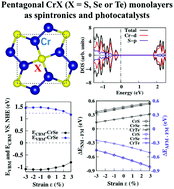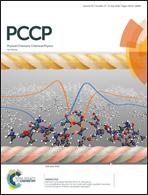Two-dimensional pentagonal CrX (X = S, Se or Te) monolayers: antiferromagnetic semiconductors for spintronics and photocatalysts†
Abstract
Two dimensional (2D) materials with hexagonal building blocks have received tremendous interest in recent years and show promise as nanoscale devices for versatile applications. Herein, we propose a new family of 2D pentagonal CrX (X = S, Se or Te) monolayers (penta-CrX) for applications in electronics, spintronics and photocatalysis. We find that the 2D penta-CrX monolayers are thermally, structurally and mechanically stable. The penta-CrX monolayers are antiferromagnetic and semiconducting. We show that the magnetism is attributed to the super-exchange induced by the ionic interactions between the Cr and X atoms and can be enhanced upon applying tension. We further show that the penta-CrS and penta-CrSe monolayers show good redox potentials versus a normal hydrogen electrode, and their band gaps are comparable to the energy of a photon in the visible light region, indicating their capability of maximal utilization of solar energy for water splitting. With intrinsic semiconducting and controllable magnetic properties, the proposed penta-CrX monolayers may hold promise as flexible spintronics and photocatalysts.



 Please wait while we load your content...
Please wait while we load your content...
